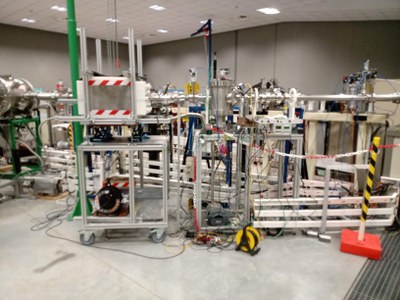Basic Nuclear data
Alpha-Neutron Reactions
Unveiling Alpha-Neutron Reactions: Project Overview and Significance
Project Objective:
This project delves into the intriguing world of alpha-neutron reactions, aiming to shed light on their properties and broaden our scientific understanding. To achieve this, we are actively developing a novel neutron detector named miniBELEN.
Motivation and Context:
Alpha-neutron (α,xn) reactions play a crucial role in various applications, including nuclear astrophysics, neutron backgrounds in underground labs, and reactor technology. However, much of the existing experimental data is decades old, often incomplete or inconsistent. To address these shortcomings and fill the knowledge gap, new, precise measurements are crucial for advancing scientific understanding.
Addressing the Gap: The MANY Collaboration:
The MANY collaboration, a joint effort by Spanish research groups and scientific facilities, aims to address this gap by measuring (α,xn) reaction cross-sections.
Experimental Setup:
- Alpha beams: Produced by the accelerator facilities at CMAM (Madrid) and CNA (Sevilla).
- Neutron detection:
- miniBELEN: A high-efficiency (up to 10 MeV) 4π long counter that directly measures neutrons using He-3 gas-filled proportional counters.
- MONSTER: A time-of-flight neutron spectrometer utilizing liquid scintillation modules.
- LaBr3(Ce) detectors: Provide fast-timing and gamma detection capabilities.
- Initial Measurement: The well-known 27Al(α,n)30P reaction has been measured at CMAM using both miniBELEN for direct neutron counting and LaBr3(Ce) scintillators for activation analysis.

Front view of miniBELEN detector at UPC
Reaction Yield Measurement:
Our project focuses on measuring the 27Al(α,n)30P reaction cross-section as a function of energy, conducted at CMAM. To determine the reaction yield (number of neutrons per incident alpha particle), we employ two techniques:
- Direct Neutron Counting: miniBELEN directly measures emitted neutrons, offering high sensitivity and real-time monitoring.
- Time-of-Flight (TOF) Technique: MONSTER measures the time taken for neutrons to travel a known distance, enabling neutron energy and yield calculation.
- Activation: of targets placed nearby the experimental setup so that its activities can be measured with LaBr3(Ce) detectors.

miniBELEN installed at the CMAM accelerator facility
Scientific Program and Collaboration:
Beyond the 27Al(α,n)30P reaction, the project aims to establish a comprehensive scientific program for alpha-neutron reactions within Spain. This program will leverage expertise and infrastructure, paving the way for future exploration of diverse reactions, including those planned at Centro Nacional de Aceleradores (CNA) in Seville.
Strategic Choice of 27Al(α,n)30P Reaction:
This reaction is strategically chosen for Benchmarking: Its existing, well-defined cross-section allows for verification of the performance of both miniBELEN and MONSTER detectors.
Overall Significance:
This project holds significant value due to its multifaceted contributions:
- Detector Development: Advances detector technology for alpha-neutron studies in underground laboratories.
- Reaction Yield Measurement: Provides valuable data for various scientific fields while verifying detector functionality.
- Collaborative Scientific Program: Fosters collaboration between research institutions and lays the foundation for long-term research in Spain.
This project represents a crucial step in understanding alpha-neutron reactions by facilitating future collaborative scientific exploration in this fascinating domain.
n_ToF project (n,gamma) reactions

Unveiling the Secrets of Neutron Interactions: The n_TOF Project
Nuclear Reactions Under the Microscope
The n_TOF project, launched in 2001 at CERN, delves into the fascinating world of neutron-induced nuclear reactions. This cutting-edge facility utilizes pulsed neutron beams to precisely measure reaction probabilities, known as cross sections. This information is critical for various scientific fields, including:
- Basic Nuclear Physics: Understanding the fundamental forces governing nuclear interactions.
- Nuclear Astrophysics: Unraveling the mysteries of how heavy elements are forged in stars, a process called stellar nucleosynthesis.
- Nuclear Technology: Developing safer and more efficient nuclear reactors.
The Power of Time-of-Flight
At n_TOF, the neutron beams boast an impressive range of energies (up to 20 GeV) delivered in short bursts. To determine the energy of each neutron, a technique called "time-of-flight" is employed. This method measures the time it takes a neutron to travel a known distance, revealing its energy based on its speed.


n_TOF Experimental areas

4π calorimeter at the n_TOF experimental area
n_TOF: A Global Leader
The combination of high-intensity neutron flux, exceptional energy resolution, and broad energy range makes n_TOF a premier facility for studying neutron-induced reactions. Researchers from around the world collaborate on experiments that push the boundaries of our knowledge.
Spanish Researchers at the Forefront
Spain contributes to 20% of the n_TOF project. Our research group has actively participated in groundbreaking n_TOF experiments, particularly those focused on stellar nucleosynthesis. In 2015, we played a leading role in measuring the neutron capture cross-section of the radioactive isotope Thallium-204, a crucial step in understanding the abundance patterns of heavy elements formed in stars. This data has significant implications for estimating the age of the elements in our Solar System.
Building on Success: The 205Tl Experiment
Building upon this achievement, our group proposed and led the measurement of the capture cross section for Thallium-205 in 2018. This further refines our understanding of the production of heavy elements through the s-process and its impact on the abundance of lead isotopes in the Solar System.
The n_TOF project, with its Spanish researchers at the forefront, is a shining example of international collaboration unlocking the secrets of nuclear reactions and stellar evolution. As we delve deeper into the world of neutrons, we gain a clearer picture of the universe's origins and the intricate processes that shaped our existence.